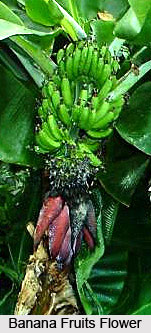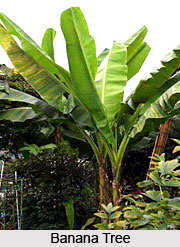 Banana tree is one of the most extensively cultivated plant species in the tropical countries. The scientific name of banana tree is `Musa Sapientum Paradisiaca`. This tree belongs to `Musaceae` family. It is named as `Kela` and `Amrit` in Hindi. Further, it is known as `Kaula`, `Champa`, `Chinee-champa` or `Dhakkai` in Bengali. In Malayalam, banana is called as Vala and in Tamil, it is called as Valai. Interestingly, Banana tree is a huge, herbaceous tree that does not form a woody stem. This tree is found in all parts of the country and occasionally it can reach a height of around 1500 metres. Banana tree also has the capability of growing in dry district if the irrigation is done properly. In this country, banana refers to that variety, which can be eaten in its raw form. In India, various types of bananas are cultivated that vary hugely in colour, size and shape.
Banana tree is one of the most extensively cultivated plant species in the tropical countries. The scientific name of banana tree is `Musa Sapientum Paradisiaca`. This tree belongs to `Musaceae` family. It is named as `Kela` and `Amrit` in Hindi. Further, it is known as `Kaula`, `Champa`, `Chinee-champa` or `Dhakkai` in Bengali. In Malayalam, banana is called as Vala and in Tamil, it is called as Valai. Interestingly, Banana tree is a huge, herbaceous tree that does not form a woody stem. This tree is found in all parts of the country and occasionally it can reach a height of around 1500 metres. Banana tree also has the capability of growing in dry district if the irrigation is done properly. In this country, banana refers to that variety, which can be eaten in its raw form. In India, various types of bananas are cultivated that vary hugely in colour, size and shape.
Description of Banana Tree
 The banana plants grow in an interesting way as they never spring from seeds. The young plants that sprout from the old tuber circulate them. In the start, this sprout gets its food from the parent plant, but within a very small time span they begin to form their own leaves and roots. The parent plant is over when the fruit has all been cut. The development of banana tree is very speedy. The stem quickly becomes around 6 metres in height. The stem comprises concentric layers and each of the layers is discernible to a leaf. The leaves are elegantly arched and are very long and four-sided figure. Their colour is bright green. The new young leaves are of translucent green colour.
The banana plants grow in an interesting way as they never spring from seeds. The young plants that sprout from the old tuber circulate them. In the start, this sprout gets its food from the parent plant, but within a very small time span they begin to form their own leaves and roots. The parent plant is over when the fruit has all been cut. The development of banana tree is very speedy. The stem quickly becomes around 6 metres in height. The stem comprises concentric layers and each of the layers is discernible to a leaf. The leaves are elegantly arched and are very long and four-sided figure. Their colour is bright green. The new young leaves are of translucent green colour.
The tiny leaves remain very much rolled round on themselves. As a result, not a single drop of rain can penetrate to the heart of the plant. The last leaf of this tree appears just before the emergence of flower stalk from the centre. The last leaf is quite small in size. Moreover, the tree`s flower stalk appears when the tree is around 12 to 15 months old. The proper stem of the plant rises from the bulb, however the leaf`s tube sheaths. The tree`s female flowers remain covered in groups by bracts at the stalk`s base. A cluster of neutral flowers stays ahead of the female flowers forming useless fingers of fruit. On the other hand, the male flowers of the tree remain at the tremendous end and they stay in solid groups underneath hinged bracts. They open in turn to reveal the flowers.
Banana tree is considered as an emblem of prosperity and fertility and thus it is frequently used in almost all the Indian festivals. Almost every part of banana tree has some economic or medicinal uses. Like for instance, the skin of the fruit is used in dyeing and the sap consists of tannin and makes a black stain on cloth. Because of this quality, it is used as marking ink. The flowers and the central portion of the buds, stem and shoot are usually cooked them as vegetables. Fibres can be made from the dried leaf stalks and used for tying fences. Banana tree`s roots, flowers, stem and leaves can be used in treating a number of illness. Thus, it can be said that banana tree is known in the country for its vast usefulness.



















